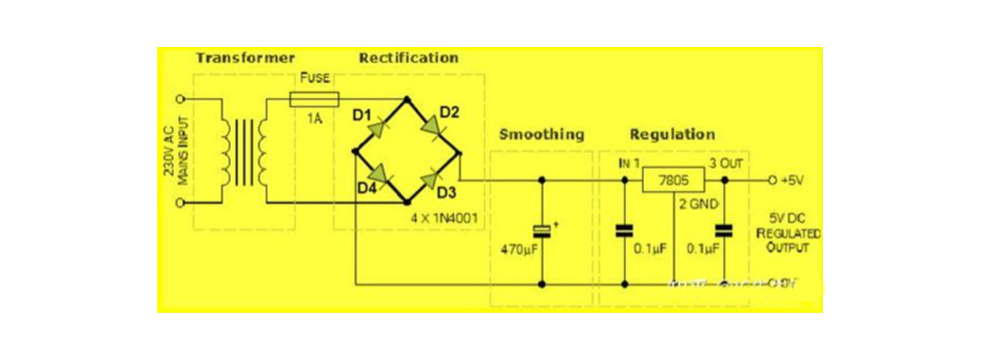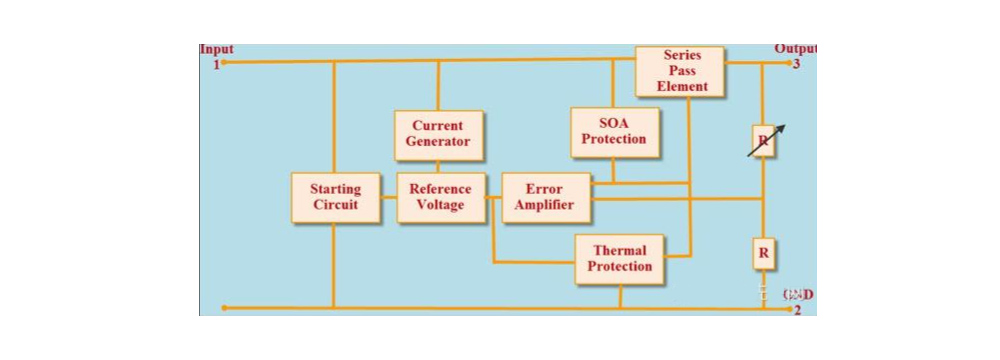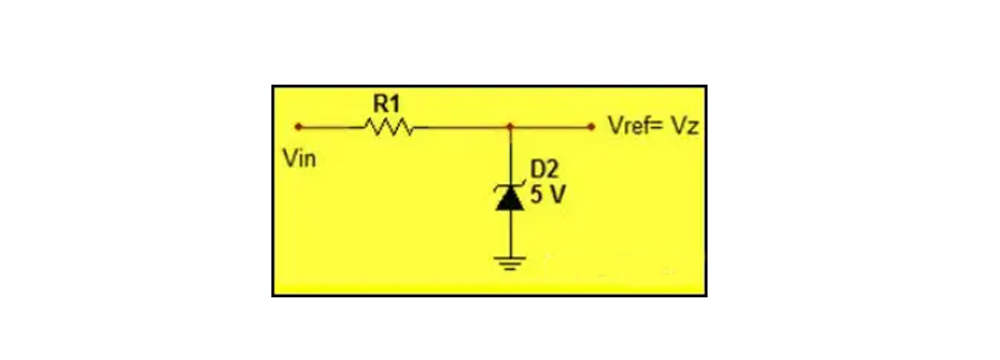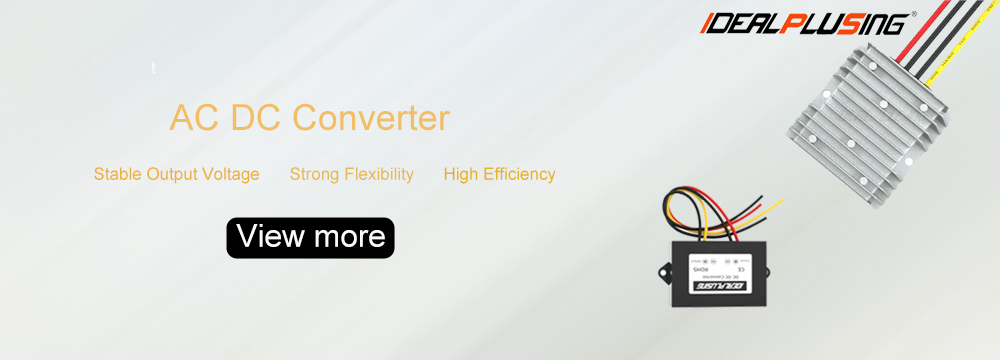When electronic components work, they need to be powered by a DC power supply. However, due to the high cost of batteries, people usually only use devices with low power consumption. To change this situation, there is a way to solve the problems encountered by transferring AC to DC power. What method is used?
1. Introduction to AC to DC power supply
Usually, the DC power supply obtained by stepping down, rectifying, filtering and stabilizing the DC power supply is a DCDC power supply. The rectifier circuit converts the industrial frequency AC power into pulsating DC. The filter circuit filters out the AC component in the pulsating DC, reduces the AC component, and increases the DC component. The voltage stabilization circuit uses negative feedback technology to further stabilize the rectified AC voltage.
2. What is AC power supply?
Alternating current (AC) power is the standard format of electricity from the socket. The name comes from the waveform adopted by the current. To understand the composition of the AC wave, you need to understand that the current comes from the flow of electrons. When the electrons in the AC wave move, they can move in the positive direction, which corresponds to the upward part of the sine wave produced by the current. When the electrons have a negative flow, the wave goes down. These waves come from the AC generator in the power plant, which produces AC. Inside the AC generator, a loop of wire rotates within a magnetic field. When the wire moves to an area of different magnetic polarity, the rotation creates waves of AC electricity. For example, when the wire rotates from the north pole area to the south pole area of the magnetic field, the current changes direction. The waves generated in the AC generator are very important for the use of AC power. The wave-like motion of AC makes this form of electricity superior to DC. Because it moves in waves, this form of electricity can travel farther than DC. Most outlets in buildings provide AC power. While many electronic devices, such as lights and appliances, use AC power, other devices require the power to be converted to DC format.
3. What is DC power?
Direct current (DC) power uses electrons that move in a straight line. This linear motion, as opposed to the waves of AC, gives this current its name. This form of electric current comes from batteries, solar cells, fuel cells, AC generators equipped with commutators that produce direct energy, and rectifiers that convert from AC to DC. Because DC power is very consistent in the voltage it provides, most electronic devices require this type of power. This is why most electronic products have a DC power source in the form of a battery or require a rectifier to convert the AC power from the outlet to DC. Power supplies usually have built-in rectifiers and transformers to step up or down the voltage to the appropriate level. For some devices, such as laptops, constant voltage is preferred. For such devices, if you want to run these electronic devices from an outlet, you need an AC-DC power converter. The converter converts the waveform into a stable straight line. Electronics are better off using DC because the highs and lows of AC can damage the delicate components inside electronic devices. 4 Simple Steps to Convert AC to DC
3.1 Reduce Voltage Levels
Step-up transformers are used to step up voltage and step-down transformers are used to step down voltage. So, by using a step-down transformer, the available 230V AC power is converted to 12V AC. The output of this step-down transformer is an effective value, and its peak value can be given by the product of the square root of 2 and the effective value, which is about 17V Step-down transformer There are two windings in the step-down transformer, the primary winding and the secondary winding, where the primary winding has more turns than the secondary winding (less turns). As we know, the working principle of the transformer is Faraday's law of electromagnetic induction. 2. The AC to DC power converter circuit mainly steps down the 230V AC power supply to 12V AC (12V RMS value, peak value is about 17V), but a 5V DC power supply is required. Therefore, this stepped-down output 17V AC power supply must be converted to DC power supply and then stepped down to 5V DC. The AC to DC converter, i.e., the rectifier, is used to convert 17V AC to DC, and there are different types of rectifiers, such as half-wave, full-wave, and bridge rectifiers. Compared with half-wave, full-wave, and bridge rectifiers, bridge rectifiers are preferred.
3.2 AC to DC converter circuit
It mainly steps down the 230V AC power supply to 12V AC (12V RMS value, peak value is about 17V), but a 5V DC power supply is required. Therefore, this stepped-down output 17V AC power supply must be converted to DC power supply and then stepped down to 5V DC. AC to DC converter i.e. rectifier is used to convert 17V AC to DC and there are different types of rectifiers such as half wave, full wave and bridge rectifiers. Bridge rectifier is preferred compared to half wave, full wave and bridge rectifiers.

AC to DC converter circuit
A rectifier consisting of four diodes connected in a bridge is called a bridge rectifier. As we know, a diode conducts electricity in only one direction (only during forward bias) and remains off in the other direction (during reverse bias). A diode is usually uncontrolled i.e. whenever the anode voltage becomes greater than the cathode, it starts conducting until the anode voltage becomes less than the cathode. Therefore, a diode is called an uncontrolled rectifier. In the above circuit, during the positive half cycle of the power supply, diodes D2 and D4 are conducting, while during the negative half cycle of the power supply, diodes D1 and D3 are conducting. In this way, the input AC power is rectified into the output DC power; but the DC output power consists of pulses, so it is called pulsating DC, not pure DC. However, due to the internal resistance of the diode, a voltage drop of (2*0.7V) 1.4V occurs, so the peak voltage of the rectifier circuit is about 15V (17-1.4).
3.3. Obtaining Pure DC from Pulsating DC
15V DC can be regulated to 5V DC by a buck converter, but before that, a pure DC power supply needs to be obtained. A pure DC power supply can be obtained from a pulsating DC using a filtering circuit (an L filter or C filter or RC coupling filter can be used to remove the ripple). C filters are often used for smoothing purposes.

Smoothing filter to obtain pure DC
In the circuit, the capacitor is used to store energy when the input voltage increases from zero to the peak value, and the energy of the capacitor can be released when the input voltage decreases from the peak value to zero. Therefore, by this charging and discharging process of the capacitor, the pulsating DC can be converted to pure DC.
3.4 Regulating DC voltage
The 15V DC output voltage can be regulated using a DC voltage regulator, such as IC 78XX, where the last two digits XX - represent the output voltage value. Here, let us consider IC 7805, which is used to maintain a constant 5V DC output even if the input is a varying DC voltage (7.2 to 35V DC).

Internal Diagram of IC 78XX DC Regulator
The above figure is the block diagram of IC7805 DC regulator, which consists of an operational amplifier as an error amplifier, a Zener diode used to provide a voltage reference, as shown in the figure below.

Zener Diode as Voltage Reference
The series transmission element (transistor) is used to dissipate the extra energy, as the heat sink and heat sink can be used for thermal protection.
4. AC to DC Power Supply Method
We generally divide it into three categories according to the type of DC power supply, namely half-wave rectifier circuit, full-wave rectifier circuit and single-phase bridge rectifier circuit. The detailed description is as follows:
4.1 Half-wave rectifier circuit: This method is achieved by the unidirectional conductive performance of the diode, mainly through half of the cycle of the transformer to achieve the load. The other half cycle is blocked by the diode, but there is no current. Converting DC power in this way can effectively reduce the efficiency of the transformer and improve the regulation of the filter circuit.
4.2 Full-wave rectifier circuit: This method is to apply a bridge circuit composed of four diodes to the transformer and half-wave rectifier circuit. Second, the number of turns of the transformer secondary winding is doubled, and the middle tap is actually composed of two secondary coils. The middle tap is connected to the load end, and the other two terminals are connected to the other end of the load end after the diode is connected.
4.3 Single-phase bridge rectifier circuit: This method is the most important method for AC and DC power. When studying the rectifier circuit, the diode in the circuit has a unidirectional conductive property. In the positive half cycle, diodes D1 and D3 are turned on and off, and the positive half cycle of the sine wave is obtained on the load resistor. When diode D2 is in the negative half cycle, D4 is turned on and off, and the negative half cycle of the sine wave is obtained on the load resistor. By generating positive and negative half cycles on the load resistor, a unidirectional pulsating voltage in the same direction can be obtained.
Converting alternating current (AC) to direct current (DC) is the basis for powering electronic devices. Whether it is household appliances, industrial equipment or portable electronic products, this key process is indispensable.
With the development of technology, AC-DC conversion solutions are also being continuously optimized. From traditional linear power supplies to efficient switching power supplies, the conversion efficiency and stability have been significantly improved. When choosing a suitable conversion method, we must consider the balance between cost and efficiency, as well as the complexity of the circuit and the needs of the application scenario.
Mastering the principles of AC-DC conversion can not only help us better understand the power supply mechanism of electronic devices, but also provide important references in circuit design, troubleshooting, and optimizing power supply solutions. In the future, with the advancement of power electronics technology, more efficient and intelligent power conversion solutions will continue to promote the development of the electronics industry.
Share our interesting knowledge and stories on social media














